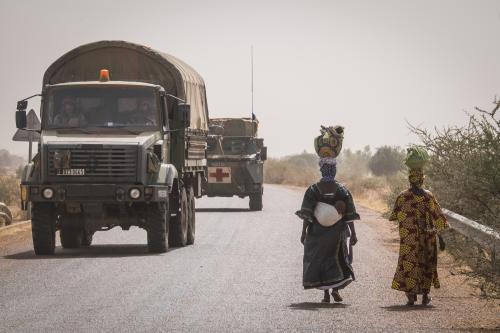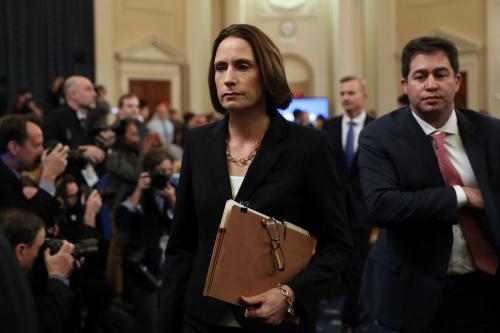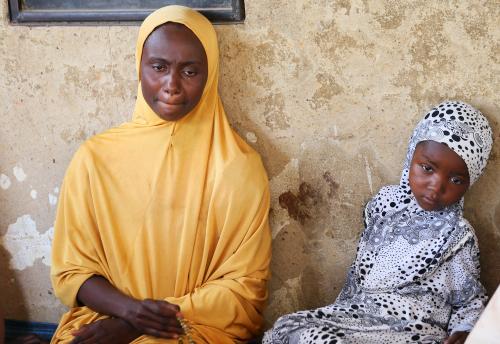In the wake of the horrendous attacks of September 11, and with an enemy as loosely defined as international terrorism, it is no surprise that we, as a nation, are groping for solutions. The events of September 11 reminded us that the frustrations of poor or unhappy people in faraway lands are much closer to home than we imagine. It seems logical to surmise that increasing our wavering commitment to foreign aid is at least part of the solution. But as with many other proposed strategies for dealing with the terrorist attacks, establishing a clear cause and effect between economic development and terrorism is far from straightforward.
Unanswered Questions
The richest country in the world by many measures, the United States lags behind all other industrialized countries in terms of the share of gross national product going to official development assistance. It will remain in last place even if the full $10 billion aid increase proposed by the administration is appropriated and disbursed over the next three years. The United States is currently second—well behind Japan—in terms of net resources going to development assistance (see table 1). Only four countries—Denmark, Holland, Norway, and Sweden—have met or exceeded the 0.7 percent of GNP target for donors established by the United Nations.
Increasing foreign assistance may have merit on a number of scores. Yet it is not clear that the terrorist problem can be solved by foreign aid, even in the long term. As a starting point, we know little about the links between economic underdevelopment—more specifically poverty—and terrorism. The perpetrators of the September 11 attacks were neither poor nor uneducated. True, terrorists often come from or seek asylum in poor countries, from Libya to Afghanistan to the Philippines. But not all poor countries have problems with terrorism, nor do their governments provide safe haven for terrorists.
Another variable in the equation, about which even less is known, is inequality and changes in the distribution of income. Economic development itself can increase inequality. Most studies find that countries that open their economies and join the global economy do better at reducing poverty. Yet the findings on inequality are much more mixed, as initial progress often increases rather than decreases within-country inequality. Decades ago, Albert Hirschman likened development to the break-up of traffic jammed in a tunnel. At first, progress in some lanes gives people in the stalled lanes hopeful expectations for the future. But if their lanes remain stalled long after other lanes move, frustration can mount and provoke radical behavior, like jumping the median strip.
Although economic development ultimately makes societies better off, in the short run it creates winners and losers. As Samuel Huntington has noted, social unrest flourishes not in countries mired in poverty, but in those that are developing and changing, either for good or for ill, raising or diminishing expectations.
When development alters relative income levels—and relative rewards to different economic sectors—even “winners” can become frustrated. Based on surveys in Peru and Russia, Stefano Pettinato and I found that more than half of the respondents whose income grew over a 10-year period assessed their new status as “negative” or “very negative” compared with their past position. And middle-income respondents were much more critical—even when their income had grown—than were the poor. We attribute these frustrations to heightened expectations, exacerbated perhaps by the global flow of information; to widening income gaps between the middle classes and the very wealthy; and to the precarious nature of income gains in the absence of adequate safety nets and social insurance.
Such findings by no means discount the role of economic development in vastly improving the lives of millions of people. That progress can and will continue—but it will be uneven and may well entail dislocation, frustration, and even social unrest. Our findings do suggest that international assistance, both technical and financial, can help countries manage development, for example by providing better safety nets and social insurance systems.
Can Aid Reduce Poverty?
Even if the links between economic development or poverty reduction and terrorism were clearly established, many questions remain about what foreign aid can accomplish. Aid has been more effective in the arenas of humanitarian relief, family planning, and reductions of infant mortality than in spurring economic growth. Yet growth is clearly necessary for reducing poverty. Aid has promoted growth in some countries, while in others it has failed or even been counterproductive.
Over the years foreign aid—from both bilateral and multilateral donors—has been directed at many different objectives. During the 1960s and 1970s, aid was driven primarily by the security concerns of the Cold War, with an underlying focus on reducing poverty. During the debt crisis of the 1980s, the rationale for aid shifted to limiting the liability that developing country debts increasingly placed on the international economic system. Concerns about reducing poverty also resurfaced, this time complicated by a new emphasis on promoting democracy and human rights. During the 1990s, still other priorities, such as supporting export markets in developing countries, arose.
Although economic growth is hardly ever the sole objective of aid, it is a necessary condition for meeting most of aid’s broad objectives. In considering whether aid can also be targeted against terrorism, it is useful to review the evidence on how well it has met the goals of stimulating economic development and reducing poverty.
Several 1990s studies of financial aid—given by both bilateral and multilateral donors and conditioned on recipient countries’ macroeconomic policies—found no positive link between aid and economic growth. Some research, such as recent work by William Easterly, even finds that aid hinders growth, particularly in low-income countries. Yet even these studies acknowledge that the broader policy orientation that conditioned foreign aid seeks to promote—open economic policies with prudent fiscal management—is producing strong results worldwide. While some countries with little or no foreign aid have enjoyed strong growth because of market-oriented policies, others, despite increasing levels of conditioned aid, continue unsound economic policies.
These findings have multiple explanations. One is that the continued flow of aid postpones the need to develop public support for economic reform. It also weakens policymakers’ commitment to prudent economic policies.
Aid that continues even in the face of poor macroeconomic policies postpones fiscal crises that can spur domestic consensus in favor of reform. In an earlier study of 55 developing countries, Easterly—with the late Michael Bruno—found that in countries where inflation reached crisis proportions (more than 40 percent), growth initially fell precipitously, but recovered quickly after prices were stabilized and then reached and maintained higher levels than before the crises. The crises seemed to give governments the political latitude to implement the structural reforms—trade liberalization, pension reform, and central bank independence—that sustain growth. In all these countries, aid declined before the onset of financial crisis.
Not surprisingly, aid stimulates growth most effectively when it flows to countries with open trade, low inflation, and sound fiscal policies. But a country’s growth performance is not always central in determining how aid, particularly bilateral aid, is allocated. As is evidenced by the high proportion of U.S. bilateral aid to Egypt and Israel, the strategic interests of national donors are usually more decisive than any interest in rewarding responsible economic policies.
Donor agencies are well aware of these problems, which is why international financial institutions, such as the International Monetary Fund and the World Bank, attach conditions to most loans. Conditionality is intended to avoid misallocation of aid, as well as to encourage prudent macroeconomic and public spending policies. Even conditional lending has a mixed record, however. One reason is that often multiple conditions are attached to loans, thus undermining local commitment to the proposed policies. Another is that donors often have strong incentives to continue lending even when conditions are not met, either because of strategic political interests or because of past lending to highly indebted countries, which makes the specter of insolvency very costly to lenders as well as borrowers.
Policymakers in the multilateral institutions have seriously debated moving to more selective lending with fewer conditions, with future eligibility for loans hinging on how well a country implements reforms. While appealing in theory, in practice such a move would entail withdrawing aid from many poor countries, particularly in Africa, and could have high social costs. It would also require much more coordination between bilateral and multilateral aid efforts—surely a welcome development, but one that would require an unprecedented degree of political consensus among donors.
Ultimately, aid is most effective when it influences policy at the level of ideas: when reforms are endorsed by a critical mass within society and then implemented as sustainable policies. The experience of many East Asian countries in the 1970s and Latin American countries in the 1980s and 1990s supports this proposition. In countries with poor policies, the most effective form of support may not be large financial flows, but rather technical assistance, ideas, and the promise of financial assistance in the future. The same studies that find a weak and even negative relationship between aid and growth also find that aid does boost growth when countries have good policies. And there has been gradual progress. Recent research by David Dollar, Craig Burnside, and Paul Collier of the World Bank finds—remarkably—that in 1990 countries with bad policies and institutions got more aid—an average of $44 per person—while those with good policies got less—$39. But by the late 1990s, those with good policies got $29 a head, while those with poor policies got only $16. These improvements have been driven primarily by changes in the practices of multilateral rather than bilateral donors.
Fighting Terrorism with Foreign Aid: Some Don’ts and Do’s
Given aid’s mixed record in supporting economic development and reducing poverty, what can we expect from aid in the fight against terrorism? The answer, in the short term, is not much. That should not, however, preclude investing in aid as a long-term, slow-growth stock in the portfolio of potential solutions. We should also make current aid efforts more effective.
The first and most obvious foreign aid “don’t”—for the United States but also for our allies—is not to provide aid to “rogue” states. During the Cold War, for example, we often provided aid to nondemocratic regimes, from which we disassociated ourselves when our objectives changed—leaving debt burdens incurred by those regimes to be financed by impoverished populations. The same temptation exists today as we seek allies in the war on terrorism.
The second “don’t” is not to continue to aid countries that pursue poor macroeconomic policies. Fears about the social costs of withdrawing aid should be met with selective humanitarian and technical assistance. In the end, prolonged aid flows to countries that pursue poor policies result in no- or low-growth traps, with high social costs in the form of poverty and unemployment. Countries that are recovering from conflict, such as Afghanistan, are usually exempted from the imperative of following market-oriented policies, but the exemption should be temporary to keep such countries from falling into low-growth, aid-dependency traps.
Perhaps the most important foreign aid “do” is to continue to support the international financial institutions in their efforts to give effective (and selective) economic aid and, equally important, to make the global financial architecture more responsive to new and continuing challenges. Chief among these challenges are volatility in world capital markets, widening inequality among and within countries, the absence of effective and sustainable safety nets and social insurance in many countries, the burden of excessive debt for the poorest countries, the need for affordable vaccines for infectious diseases, and the need to protect the environment. Although far from flawless, the international financial institutions are by far the most effective aid instruments we have.
Not surprisingly, these institutions themselves are reevaluating their core missions and their ability to pursue them. Some critics urge them to address a broader set of issues, such as global public goods and global governance. Others contend that their agendas are already too broadly defined and that expanding them, say, to include nation building in countries such as Afghanistan weakens their effectiveness on the core goals of supporting economic development and reducing poverty.
Resolving this debate is beyond the scope of this article. Yet it is worth noting that Washington’s ability to provide leadership on these issues has been eroded in the past decade. The flagging U.S. commitment to the IMF and the World Bank has been evident in many forums, from the low U.S. ranking in official development assistance; to criticism in Congress, most explicitly the 2000 report by the Meltzer Commission, which recommended radical changes to the IMF and World Bank; to comments by Secretary of the Treasury Paul O’Neill questioning—and ultimately undermining the effectiveness of—IMF financial rescues.
In the immediate wake of September 11, Congress recognized that it was unrealistic to ask our allies and a host of other countries for support in the fight against terrorism when we were far behind in paying our dues to the United Nations. The recent increase in our commitment to development assistance is another positive step, though still insufficient to lift the richest country in the world from the bottom of the donor ranks. At the least, fulfilling this commitment over the next three years—and continued progress in the future—could help us get cooperation, both from allies and within the international financial institutions, in making aid more effective at achieving its core objectives.
Increased support for foreign aid is possible politically but requires dedicated leadership. The public foreign aid debate is woefully ill-informed. Most polls find that more than 80 percent of Americans favor some form of foreign aid, but few have any idea how much Washington spends on aid. The average response, in numerous polls, is that 15-20 percent of the federal budget goes for foreign aid. The reality is 0.05 percent—about half a penny on the federal dollar. When asked what would be appropriate, most respondents cite 5-10 percent—more than 10 times what we spend today and far more than needed to meet our objectives.
Making aid more effective requires better coordination of multilateral and bilateral donor efforts—which means vastly improving cooperation among the donor countries and the international financial institutions. Bilateral donors still account for two-thirds of all development assistance, for example. Small countries that receive aid are often unable to manage the multiple priorities and conditions of numerous donors. At the same time, the availability of numerous sources of aid can undermine even the most carefully designed loan conditions, as recipients play one donor off the other. Bilateral aid tends to be more political in nature than multilateral aid, although there are, of course, exceptions.
Finally, Washington can and should provide leadership in opening U.S. markets and broadening and sustaining our commitment to free trade. Research shows that aid is most effective in supporting sustained growth and reducing poverty in countries that pursue market-oriented policies and open trading regimes. Several previously aid-dependent countries in East Asia and Latin America, for example, where markets and democracy have taken hold, now ask us for “trade not aid.” While the United States maintains a strong rhetorical commitment to free trade, real progress has been much slower in coming. Commitments to liberalize imports of textiles and clothing made in the 1994 Uruguay Round trade negotiations remain unfulfilled. Agricultural trade remains full of distortions and barriers. The 2001 meeting of world trade ministers in Doha was a positive—if small—step in the right direction. And after a prolonged and divisive debate this May, the Senate gave the president the Trade Promotion Authority that he needs to facilitate trade agreements.
The challenge from international terrorism is, among other things, a wake-up call to concern ourselves with the fate of poor people in poor countries. In the long term, foreign aid, given selectively and not saddled with myriad objectives, can encourage economic development and reduce poverty and therefore improve the lives of many people. In the end that will make the world a better place and, it is to be hoped, one less likely to breed the violence and fanaticism we saw on September 11. It is not a magic bullet. It is a very slow growth stock. But it is worth a try. The world is small.



Commentary
Can Foreign Aid Help Stop Terrorism?
June 1, 2002